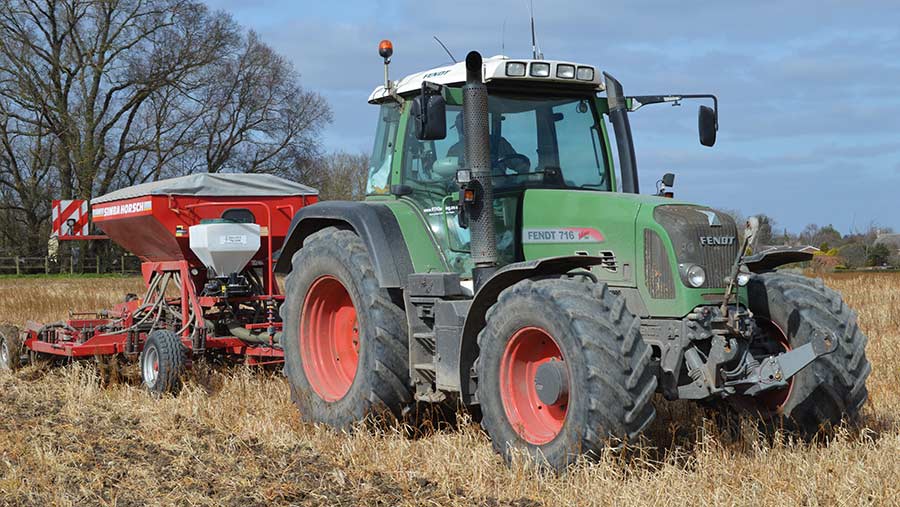Pulses good option for growers as fertiliser prices rocket
 © MAG/David Jones
© MAG/David Jones The pea and bean area could rise this season due to the sharp jump in nitrogen fertiliser prices and strong demand for these pulse crops in domestic and export markets.
These legume crops fix their own nitrogen from the atmosphere, so they do not need any nitrogenous fertiliser. This may prove attractive to farmers considering nitrogen prices have more than doubled in the past four months.
See also: Guide to growing a successful spring bean break crop
The area of beans in England for harvest 2021 edged up 3.4% to 185,000ha, and peas showed a bigger rise of 18.1% to 60,000ha. Experts in the industry consider a further rise likely, helped by good prices for these pulses.
The vast majority of UK pulses are grown in England, and their rotational benefits and low growing cost may help encourage growers to increase drillings for harvest 2022.
Roger Vickers, chief executive officer of the Processors and Growers Research Organisation (PGRO), says if nitrogen fertiliser gets really expensive in the long term, it could make pulses more attractive.
“The pea and bean area could go up a little, and there is clearly room for an increase, as they only account for 4-5% of the total arable area,” he tells Farmers Weekly.
Residual nitrogen
Mr Vickers adds that peas and beans help soil fertility and leave residual nitrogen in the soil for a following crop, so they are crops that can easily fit into a more resilient agricultural system.
With good yields from last summer’s harvest, strong prices and many farmers looking to widen their rotations, pulse crops could well become more attractive to growers.
Peas and beans also have the potential to cut imports of other protein crops such as soya beans, and could fit well into new environmentally focus farming subsidy schemes as they are low-input crops, especially in terms of nitrogen fertiliser.
Although the new Environmental Land Management scheme, which will replace the Basic Payment Scheme, has no specific mention of growing pulses, experts say the scheme’s focus on soil health means pulses may well be favoured.
Good bean prices
Crop experts add that beans have more potential for an area increase than peas because of their greater versatility – they can be used for a range of markets, including human consumption, livestock feed, fish food and exports. About 60-65% of the bean crop is sown in spring, with the remainder drilled in the autumn.
This versatility has helped feed bean prices stay strong, currently at £230-£235/t, with a £20/t premium for human consumption taking prices up to £255/t. Feed bean prices for harvest 2022 are quoted at £210-215/t.
On the human consumption side, the quality of domestically grown beans from harvest 2021 is dramatically better that the past three years, with bright, clean, well-coloured grain. Many samples also had bruchid beetle damage levels below 10%.
Strong bean demand
With a poor harvest in the major bean-exporting markets in the Baltic states, there is the expectation of good demand for UK beans by markets in north Africa to be made into falafel.
Andy Bury, UK pulse manager at trading and agronomy group Frontier, says a good harvest this summer, strong demand, high nitrogen prices and a lack of supply may encourage farmers to grow more pulses.
“With better yields and quality, and prices holding strong, farmers will have greater confidence to grow peas and beans,” he says.
“There is likely to be a bit less nitrogen used this season. Spring crops could be up in area and within that, pulse crops are likely to rise,” he says.
Among the big pulse-producing and exporting nations, the Baltic states and France have seen yields down this year, which is aiding demand for UK production and, while another big crop is expected from Australia later this year, it is likely to be at a lower level than in 2020.
Fertiliser plants
Nitrogen fertiliser prices rose sharply after Britain’s only two ammonium nitrate fertiliser plants at Billingham in Teesside and Ince in Cheshire, owned by US fertiliser maker CF Industries, closed down in September due to high energy costs.
Although Billingham has now reopened with UK government help to cope with high energy costs, the two supply about 40% of the total UK fertiliser market, so some shortages are likely to continue.
The Billingham plant reopened to help ease the shortage of one of its by-products, carbon dioxide, which is critical for sectors such as food packaging and soft drinks production.

